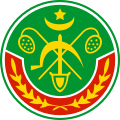Khorezm People's Soviet Republic (1920–1924) خوارزم خلق شورالر جمهوریتی خارەزم خەلق شورالەر جۇمھۇرییەتى Xorazm xalq sho'ro jumhuriyati (Uzbek) Хорезмская Народная Советская Республика (Russian) Khorezm Socialist Soviet Republic (1923–1924) خارەزم ئیجتیماعیی شورالەر جۇمھۇرییەتى Xorazm ijtimoiy sho'ro jumhuriyati (Uzbek) Хорезмская Социалистическая Советская Республика (Russian) | |||||||||||||
|---|---|---|---|---|---|---|---|---|---|---|---|---|---|
| 1920–1924 | |||||||||||||
| Motto: Butun dunyo proletarlari, birlashingiz! "Proletarians of all countries, unite!" | |||||||||||||
 The Khorezm People's Soviet Republic in 1922 | |||||||||||||
| Capital | Khiva | ||||||||||||
| Common languages | Russian, Uzbek, Turkmen, Karakalpak | ||||||||||||
| Religion |
| ||||||||||||
| Government | Soviet republic | ||||||||||||
| Chairman | |||||||||||||
• 1920−1921 (first) | Palvanniyaz Khodja Yusupov | ||||||||||||
• 1924 (last) | Sultan-Kary Dzhumaniyazov | ||||||||||||
| Historical era | Interwar period | ||||||||||||
• Abdication of Sayid Abdullah | 2 February 1920 | ||||||||||||
• Republic established | 26 April 1920 | ||||||||||||
• Part of USSR | 27 October 1924 | ||||||||||||
| |||||||||||||
| Today part of | Turkmenistan Uzbekistan Kazakhstan | ||||||||||||
The Khorezm People's Soviet Republic [a] was the state created as the successor to the Khanate of Khiva in February 1920, when the Khan abdicated in response to pressure. It was officially declared by the First Khorezm Kurultay (Assembly) on 26 April 1920. On 20 October 1923, it was transformed into the Khorezm Socialist Soviet Republic. [b] . [1]
Contents


On 27 October 1924 the Khorezm SSR was divided between the Uzbek and Turkmen SSRs and the Karakalpak Autonomous Oblast as part of the delimitation of Central Asia according to nationalities. [2] The history of this short-lived republic remains murky and the way its government functioned is not largely clear. The government officials fervently opposed the delimitation plans of the Khorezmian Republic (which had to be carried out under Stalin’s orders) but in the end they were forced to concede.


